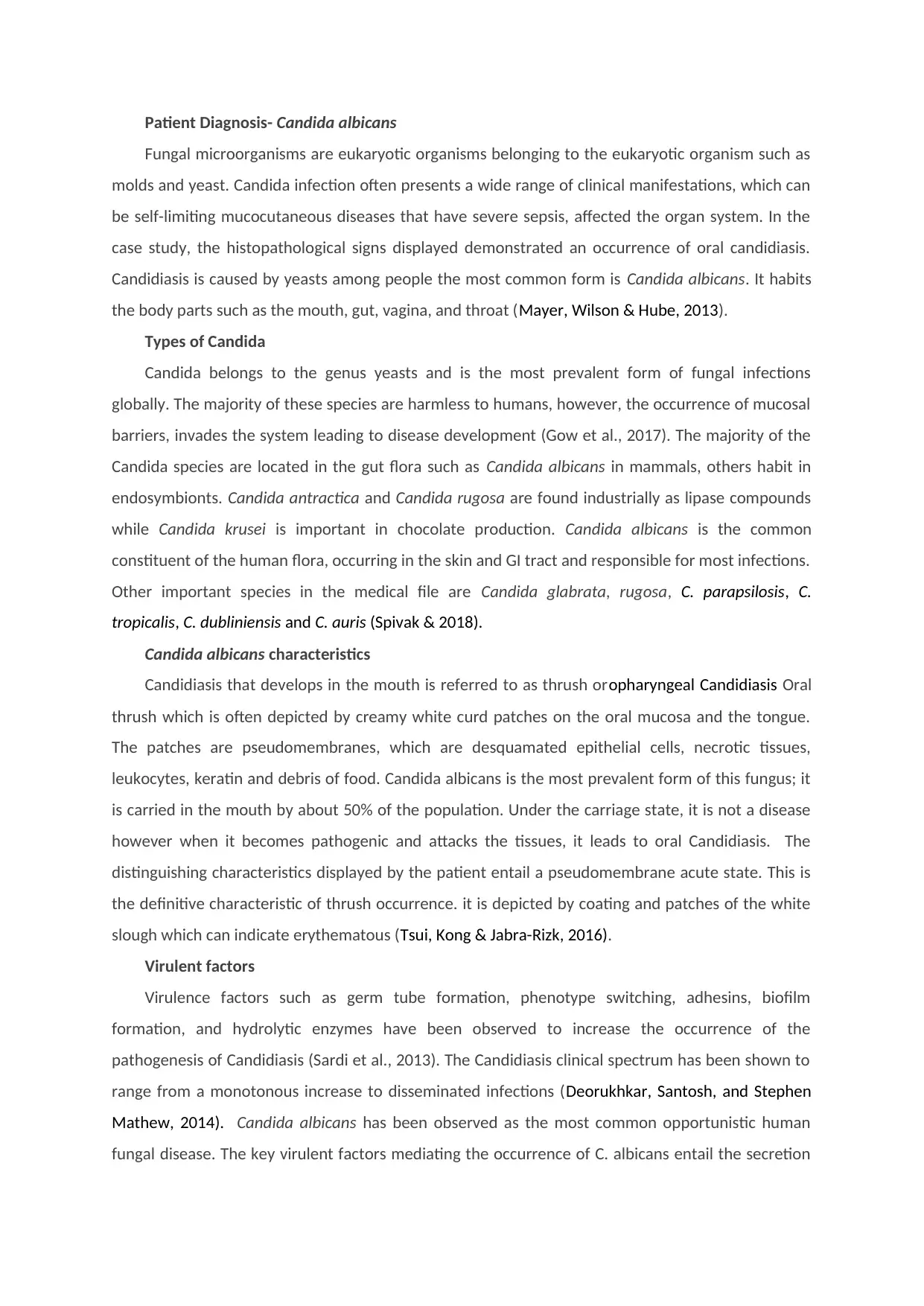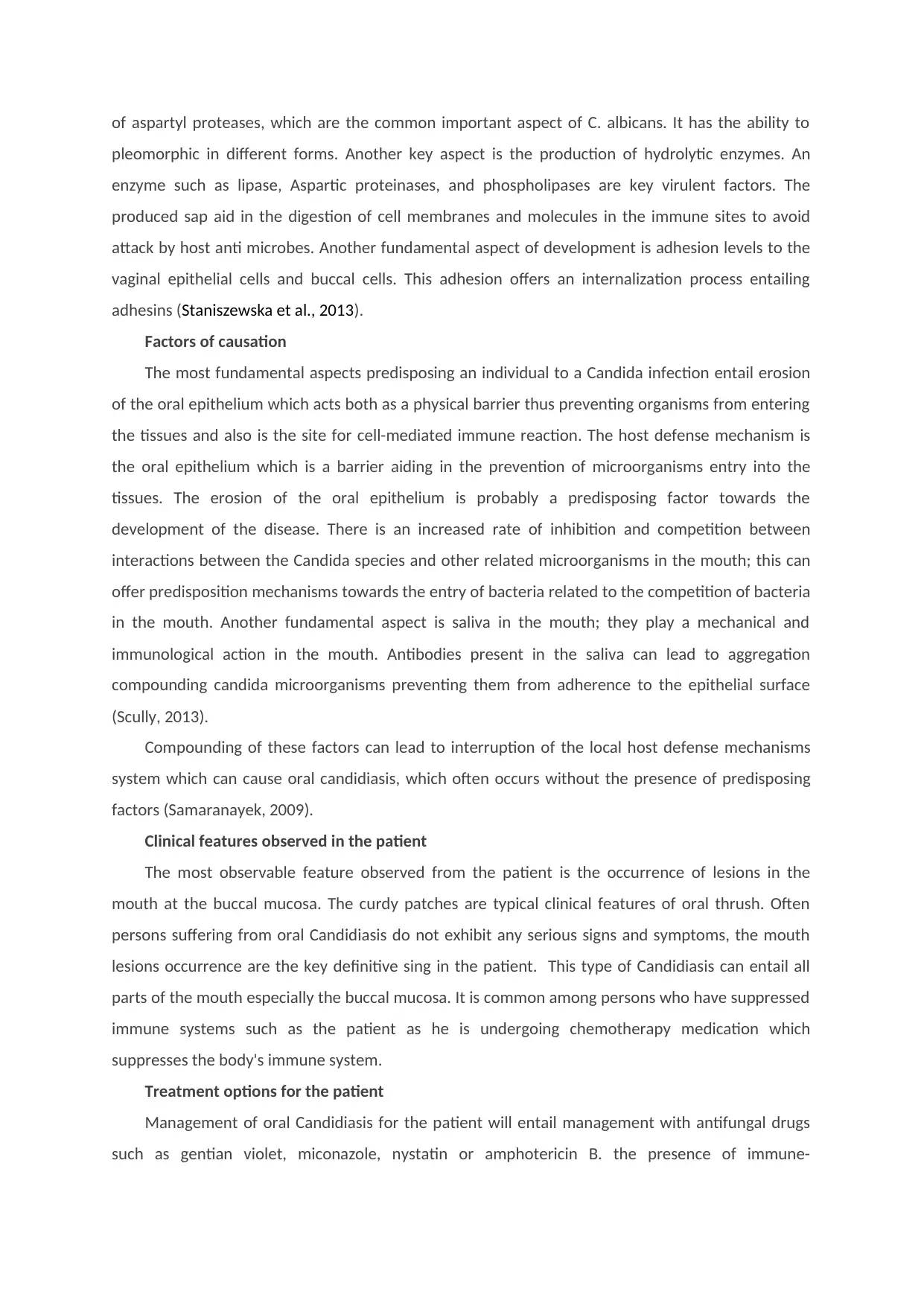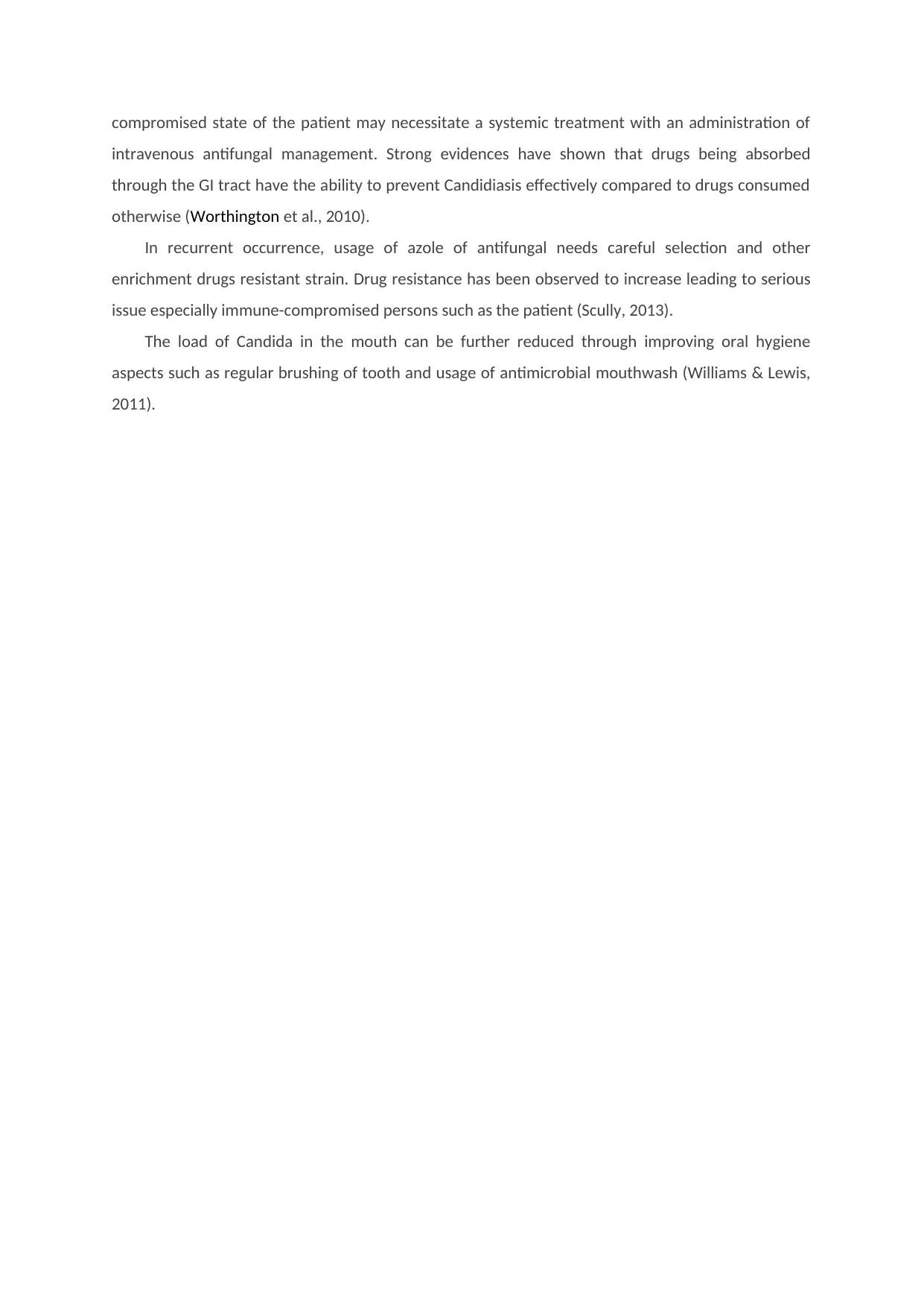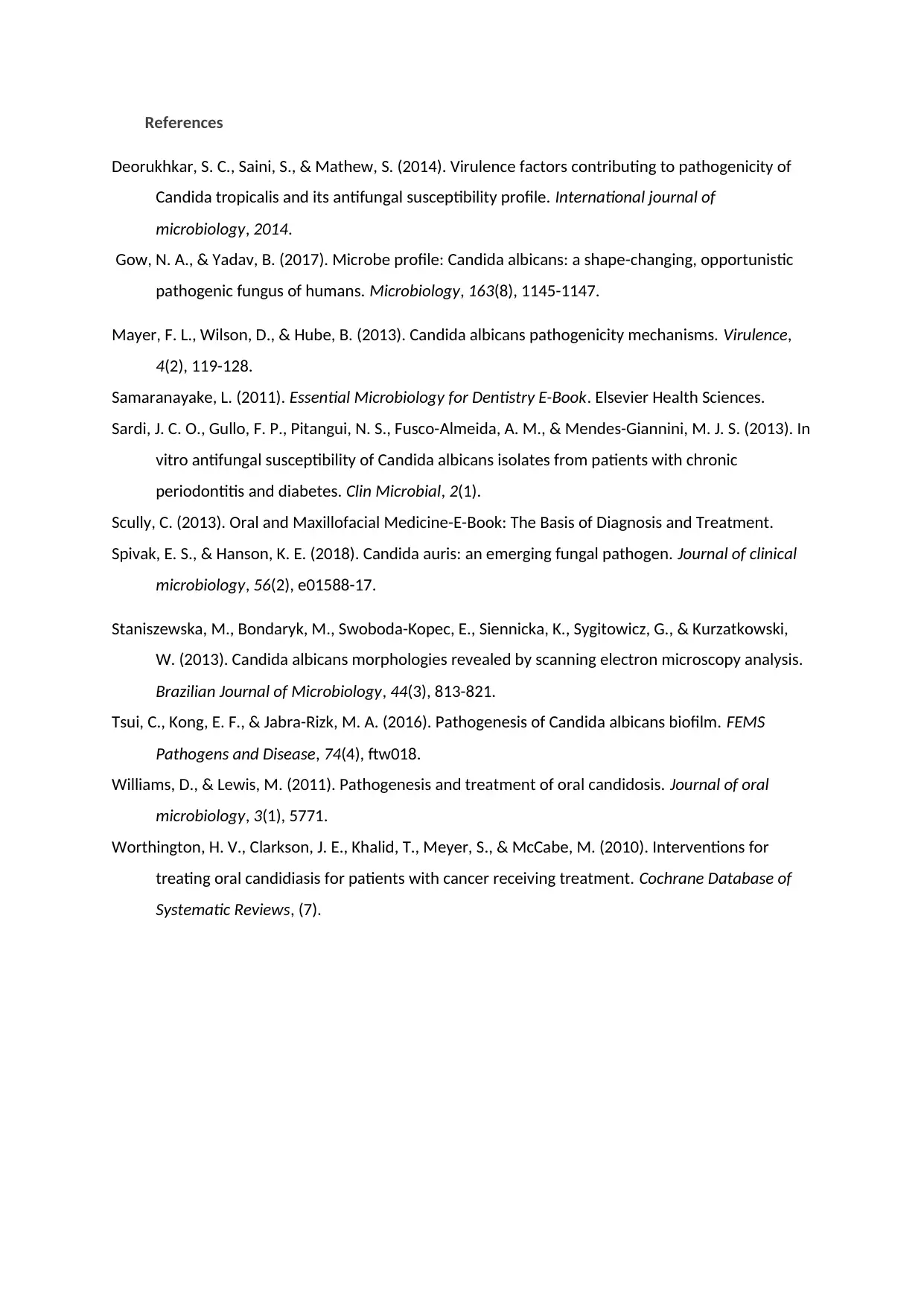University Case Study: Candida albicans Infection in Cancer Patient
VerifiedAdded on 2022/08/24
|5
|1503
|14
Case Study
AI Summary
This case study presents a 50-year-old female patient diagnosed with breast cancer who presented with white patches on the buccal mucosa and tongue, indicative of oral candidiasis. The assignment details the diagnosis of Candida albicans, exploring its characteristics, different species, and virulence factors such as germ tube formation, adhesins, and hydrolytic enzymes. It examines the factors that contribute to the disease's causation, including erosion of the oral epithelium, reduced competition with other microorganisms, and the role of saliva. The clinical features observed, including curdy patches on the buccal mucosa, are discussed in the context of the patient's chemotherapy treatment, which suppresses the immune system. Finally, the case study outlines treatment options involving antifungal drugs like miconazole and nystatin, and the importance of improving oral hygiene to manage the infection. The document emphasizes the significance of systemic antifungal treatment for immune-compromised patients and the growing concern of drug resistance.

Case Study assessment
Candida albicans
University
Task
Name
Unit
Date
Candida albicans
University
Task
Name
Unit
Date
Paraphrase This Document
Need a fresh take? Get an instant paraphrase of this document with our AI Paraphraser

Patient Diagnosis- Candida albicans
Fungal microorganisms are eukaryotic organisms belonging to the eukaryotic organism such as
molds and yeast. Candida infection often presents a wide range of clinical manifestations, which can
be self-limiting mucocutaneous diseases that have severe sepsis, affected the organ system. In the
case study, the histopathological signs displayed demonstrated an occurrence of oral candidiasis.
Candidiasis is caused by yeasts among people the most common form is Candida albicans. It habits
the body parts such as the mouth, gut, vagina, and throat (Mayer, Wilson & Hube, 2013).
Types of Candida
Candida belongs to the genus yeasts and is the most prevalent form of fungal infections
globally. The majority of these species are harmless to humans, however, the occurrence of mucosal
barriers, invades the system leading to disease development (Gow et al., 2017). The majority of the
Candida species are located in the gut flora such as Candida albicans in mammals, others habit in
endosymbionts. Candida antractica and Candida rugosa are found industrially as lipase compounds
while Candida krusei is important in chocolate production. Candida albicans is the common
constituent of the human flora, occurring in the skin and GI tract and responsible for most infections.
Other important species in the medical file are Candida glabrata, rugosa, C. parapsilosis, C.
tropicalis, C. dubliniensis and C. auris (Spivak & 2018).
Candida albicans characteristics
Candidiasis that develops in the mouth is referred to as thrush oropharyngeal Candidiasis Oral
thrush which is often depicted by creamy white curd patches on the oral mucosa and the tongue.
The patches are pseudomembranes, which are desquamated epithelial cells, necrotic tissues,
leukocytes, keratin and debris of food. Candida albicans is the most prevalent form of this fungus; it
is carried in the mouth by about 50% of the population. Under the carriage state, it is not a disease
however when it becomes pathogenic and attacks the tissues, it leads to oral Candidiasis. The
distinguishing characteristics displayed by the patient entail a pseudomembrane acute state. This is
the definitive characteristic of thrush occurrence. it is depicted by coating and patches of the white
slough which can indicate erythematous (Tsui, Kong & Jabra-Rizk, 2016).
Virulent factors
Virulence factors such as germ tube formation, phenotype switching, adhesins, biofilm
formation, and hydrolytic enzymes have been observed to increase the occurrence of the
pathogenesis of Candidiasis (Sardi et al., 2013). The Candidiasis clinical spectrum has been shown to
range from a monotonous increase to disseminated infections (Deorukhkar, Santosh, and Stephen
Mathew, 2014). Candida albicans has been observed as the most common opportunistic human
fungal disease. The key virulent factors mediating the occurrence of C. albicans entail the secretion
Fungal microorganisms are eukaryotic organisms belonging to the eukaryotic organism such as
molds and yeast. Candida infection often presents a wide range of clinical manifestations, which can
be self-limiting mucocutaneous diseases that have severe sepsis, affected the organ system. In the
case study, the histopathological signs displayed demonstrated an occurrence of oral candidiasis.
Candidiasis is caused by yeasts among people the most common form is Candida albicans. It habits
the body parts such as the mouth, gut, vagina, and throat (Mayer, Wilson & Hube, 2013).
Types of Candida
Candida belongs to the genus yeasts and is the most prevalent form of fungal infections
globally. The majority of these species are harmless to humans, however, the occurrence of mucosal
barriers, invades the system leading to disease development (Gow et al., 2017). The majority of the
Candida species are located in the gut flora such as Candida albicans in mammals, others habit in
endosymbionts. Candida antractica and Candida rugosa are found industrially as lipase compounds
while Candida krusei is important in chocolate production. Candida albicans is the common
constituent of the human flora, occurring in the skin and GI tract and responsible for most infections.
Other important species in the medical file are Candida glabrata, rugosa, C. parapsilosis, C.
tropicalis, C. dubliniensis and C. auris (Spivak & 2018).
Candida albicans characteristics
Candidiasis that develops in the mouth is referred to as thrush oropharyngeal Candidiasis Oral
thrush which is often depicted by creamy white curd patches on the oral mucosa and the tongue.
The patches are pseudomembranes, which are desquamated epithelial cells, necrotic tissues,
leukocytes, keratin and debris of food. Candida albicans is the most prevalent form of this fungus; it
is carried in the mouth by about 50% of the population. Under the carriage state, it is not a disease
however when it becomes pathogenic and attacks the tissues, it leads to oral Candidiasis. The
distinguishing characteristics displayed by the patient entail a pseudomembrane acute state. This is
the definitive characteristic of thrush occurrence. it is depicted by coating and patches of the white
slough which can indicate erythematous (Tsui, Kong & Jabra-Rizk, 2016).
Virulent factors
Virulence factors such as germ tube formation, phenotype switching, adhesins, biofilm
formation, and hydrolytic enzymes have been observed to increase the occurrence of the
pathogenesis of Candidiasis (Sardi et al., 2013). The Candidiasis clinical spectrum has been shown to
range from a monotonous increase to disseminated infections (Deorukhkar, Santosh, and Stephen
Mathew, 2014). Candida albicans has been observed as the most common opportunistic human
fungal disease. The key virulent factors mediating the occurrence of C. albicans entail the secretion

of aspartyl proteases, which are the common important aspect of C. albicans. It has the ability to
pleomorphic in different forms. Another key aspect is the production of hydrolytic enzymes. An
enzyme such as lipase, Aspartic proteinases, and phospholipases are key virulent factors. The
produced sap aid in the digestion of cell membranes and molecules in the immune sites to avoid
attack by host anti microbes. Another fundamental aspect of development is adhesion levels to the
vaginal epithelial cells and buccal cells. This adhesion offers an internalization process entailing
adhesins (Staniszewska et al., 2013).
Factors of causation
The most fundamental aspects predisposing an individual to a Candida infection entail erosion
of the oral epithelium which acts both as a physical barrier thus preventing organisms from entering
the tissues and also is the site for cell-mediated immune reaction. The host defense mechanism is
the oral epithelium which is a barrier aiding in the prevention of microorganisms entry into the
tissues. The erosion of the oral epithelium is probably a predisposing factor towards the
development of the disease. There is an increased rate of inhibition and competition between
interactions between the Candida species and other related microorganisms in the mouth; this can
offer predisposition mechanisms towards the entry of bacteria related to the competition of bacteria
in the mouth. Another fundamental aspect is saliva in the mouth; they play a mechanical and
immunological action in the mouth. Antibodies present in the saliva can lead to aggregation
compounding candida microorganisms preventing them from adherence to the epithelial surface
(Scully, 2013).
Compounding of these factors can lead to interruption of the local host defense mechanisms
system which can cause oral candidiasis, which often occurs without the presence of predisposing
factors (Samaranayek, 2009).
Clinical features observed in the patient
The most observable feature observed from the patient is the occurrence of lesions in the
mouth at the buccal mucosa. The curdy patches are typical clinical features of oral thrush. Often
persons suffering from oral Candidiasis do not exhibit any serious signs and symptoms, the mouth
lesions occurrence are the key definitive sing in the patient. This type of Candidiasis can entail all
parts of the mouth especially the buccal mucosa. It is common among persons who have suppressed
immune systems such as the patient as he is undergoing chemotherapy medication which
suppresses the body's immune system.
Treatment options for the patient
Management of oral Candidiasis for the patient will entail management with antifungal drugs
such as gentian violet, miconazole, nystatin or amphotericin B. the presence of immune-
pleomorphic in different forms. Another key aspect is the production of hydrolytic enzymes. An
enzyme such as lipase, Aspartic proteinases, and phospholipases are key virulent factors. The
produced sap aid in the digestion of cell membranes and molecules in the immune sites to avoid
attack by host anti microbes. Another fundamental aspect of development is adhesion levels to the
vaginal epithelial cells and buccal cells. This adhesion offers an internalization process entailing
adhesins (Staniszewska et al., 2013).
Factors of causation
The most fundamental aspects predisposing an individual to a Candida infection entail erosion
of the oral epithelium which acts both as a physical barrier thus preventing organisms from entering
the tissues and also is the site for cell-mediated immune reaction. The host defense mechanism is
the oral epithelium which is a barrier aiding in the prevention of microorganisms entry into the
tissues. The erosion of the oral epithelium is probably a predisposing factor towards the
development of the disease. There is an increased rate of inhibition and competition between
interactions between the Candida species and other related microorganisms in the mouth; this can
offer predisposition mechanisms towards the entry of bacteria related to the competition of bacteria
in the mouth. Another fundamental aspect is saliva in the mouth; they play a mechanical and
immunological action in the mouth. Antibodies present in the saliva can lead to aggregation
compounding candida microorganisms preventing them from adherence to the epithelial surface
(Scully, 2013).
Compounding of these factors can lead to interruption of the local host defense mechanisms
system which can cause oral candidiasis, which often occurs without the presence of predisposing
factors (Samaranayek, 2009).
Clinical features observed in the patient
The most observable feature observed from the patient is the occurrence of lesions in the
mouth at the buccal mucosa. The curdy patches are typical clinical features of oral thrush. Often
persons suffering from oral Candidiasis do not exhibit any serious signs and symptoms, the mouth
lesions occurrence are the key definitive sing in the patient. This type of Candidiasis can entail all
parts of the mouth especially the buccal mucosa. It is common among persons who have suppressed
immune systems such as the patient as he is undergoing chemotherapy medication which
suppresses the body's immune system.
Treatment options for the patient
Management of oral Candidiasis for the patient will entail management with antifungal drugs
such as gentian violet, miconazole, nystatin or amphotericin B. the presence of immune-
⊘ This is a preview!⊘
Do you want full access?
Subscribe today to unlock all pages.

Trusted by 1+ million students worldwide

compromised state of the patient may necessitate a systemic treatment with an administration of
intravenous antifungal management. Strong evidences have shown that drugs being absorbed
through the GI tract have the ability to prevent Candidiasis effectively compared to drugs consumed
otherwise (Worthington et al., 2010).
In recurrent occurrence, usage of azole of antifungal needs careful selection and other
enrichment drugs resistant strain. Drug resistance has been observed to increase leading to serious
issue especially immune-compromised persons such as the patient (Scully, 2013).
The load of Candida in the mouth can be further reduced through improving oral hygiene
aspects such as regular brushing of tooth and usage of antimicrobial mouthwash (Williams & Lewis,
2011).
intravenous antifungal management. Strong evidences have shown that drugs being absorbed
through the GI tract have the ability to prevent Candidiasis effectively compared to drugs consumed
otherwise (Worthington et al., 2010).
In recurrent occurrence, usage of azole of antifungal needs careful selection and other
enrichment drugs resistant strain. Drug resistance has been observed to increase leading to serious
issue especially immune-compromised persons such as the patient (Scully, 2013).
The load of Candida in the mouth can be further reduced through improving oral hygiene
aspects such as regular brushing of tooth and usage of antimicrobial mouthwash (Williams & Lewis,
2011).
Paraphrase This Document
Need a fresh take? Get an instant paraphrase of this document with our AI Paraphraser

References
Deorukhkar, S. C., Saini, S., & Mathew, S. (2014). Virulence factors contributing to pathogenicity of
Candida tropicalis and its antifungal susceptibility profile. International journal of
microbiology, 2014.
Gow, N. A., & Yadav, B. (2017). Microbe profile: Candida albicans: a shape-changing, opportunistic
pathogenic fungus of humans. Microbiology, 163(8), 1145-1147.
Mayer, F. L., Wilson, D., & Hube, B. (2013). Candida albicans pathogenicity mechanisms. Virulence,
4(2), 119-128.
Samaranayake, L. (2011). Essential Microbiology for Dentistry E-Book. Elsevier Health Sciences.
Sardi, J. C. O., Gullo, F. P., Pitangui, N. S., Fusco-Almeida, A. M., & Mendes-Giannini, M. J. S. (2013). In
vitro antifungal susceptibility of Candida albicans isolates from patients with chronic
periodontitis and diabetes. Clin Microbial, 2(1).
Scully, C. (2013). Oral and Maxillofacial Medicine-E-Book: The Basis of Diagnosis and Treatment.
Spivak, E. S., & Hanson, K. E. (2018). Candida auris: an emerging fungal pathogen. Journal of clinical
microbiology, 56(2), e01588-17.
Staniszewska, M., Bondaryk, M., Swoboda-Kopec, E., Siennicka, K., Sygitowicz, G., & Kurzatkowski,
W. (2013). Candida albicans morphologies revealed by scanning electron microscopy analysis.
Brazilian Journal of Microbiology, 44(3), 813-821.
Tsui, C., Kong, E. F., & Jabra-Rizk, M. A. (2016). Pathogenesis of Candida albicans biofilm. FEMS
Pathogens and Disease, 74(4), ftw018.
Williams, D., & Lewis, M. (2011). Pathogenesis and treatment of oral candidosis. Journal of oral
microbiology, 3(1), 5771.
Worthington, H. V., Clarkson, J. E., Khalid, T., Meyer, S., & McCabe, M. (2010). Interventions for
treating oral candidiasis for patients with cancer receiving treatment. Cochrane Database of
Systematic Reviews, (7).
Deorukhkar, S. C., Saini, S., & Mathew, S. (2014). Virulence factors contributing to pathogenicity of
Candida tropicalis and its antifungal susceptibility profile. International journal of
microbiology, 2014.
Gow, N. A., & Yadav, B. (2017). Microbe profile: Candida albicans: a shape-changing, opportunistic
pathogenic fungus of humans. Microbiology, 163(8), 1145-1147.
Mayer, F. L., Wilson, D., & Hube, B. (2013). Candida albicans pathogenicity mechanisms. Virulence,
4(2), 119-128.
Samaranayake, L. (2011). Essential Microbiology for Dentistry E-Book. Elsevier Health Sciences.
Sardi, J. C. O., Gullo, F. P., Pitangui, N. S., Fusco-Almeida, A. M., & Mendes-Giannini, M. J. S. (2013). In
vitro antifungal susceptibility of Candida albicans isolates from patients with chronic
periodontitis and diabetes. Clin Microbial, 2(1).
Scully, C. (2013). Oral and Maxillofacial Medicine-E-Book: The Basis of Diagnosis and Treatment.
Spivak, E. S., & Hanson, K. E. (2018). Candida auris: an emerging fungal pathogen. Journal of clinical
microbiology, 56(2), e01588-17.
Staniszewska, M., Bondaryk, M., Swoboda-Kopec, E., Siennicka, K., Sygitowicz, G., & Kurzatkowski,
W. (2013). Candida albicans morphologies revealed by scanning electron microscopy analysis.
Brazilian Journal of Microbiology, 44(3), 813-821.
Tsui, C., Kong, E. F., & Jabra-Rizk, M. A. (2016). Pathogenesis of Candida albicans biofilm. FEMS
Pathogens and Disease, 74(4), ftw018.
Williams, D., & Lewis, M. (2011). Pathogenesis and treatment of oral candidosis. Journal of oral
microbiology, 3(1), 5771.
Worthington, H. V., Clarkson, J. E., Khalid, T., Meyer, S., & McCabe, M. (2010). Interventions for
treating oral candidiasis for patients with cancer receiving treatment. Cochrane Database of
Systematic Reviews, (7).
1 out of 5
Your All-in-One AI-Powered Toolkit for Academic Success.
+13062052269
info@desklib.com
Available 24*7 on WhatsApp / Email
![[object Object]](/_next/static/media/star-bottom.7253800d.svg)
Unlock your academic potential
Copyright © 2020–2025 A2Z Services. All Rights Reserved. Developed and managed by ZUCOL.
